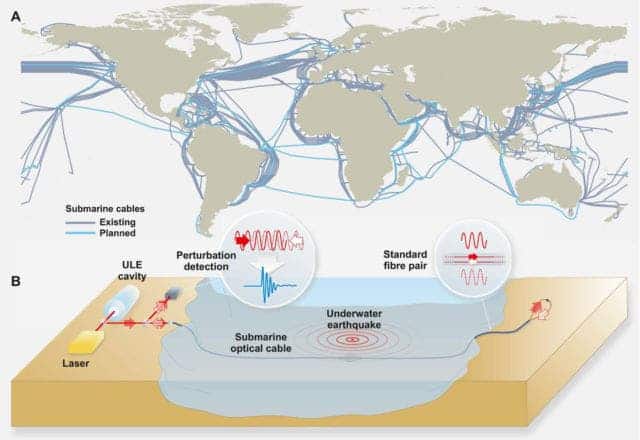With the right setup, anything that moves the cables around can be detected — and that includes earthquakes.

Detecting earthquakes is important both for assessing risks to the population and for understanding the inner structure of the Earth. Thankfully, we have enough seismometers on land to detect all but the smallest (and harmless) earthquakes — but in the sea, it’s a different story.
Over 70% of our planet’s surface is covered in water, and seismometer coverage is limited to a handful of permanent ocean bottom stations. It’s very expensive and logistically difficult to maintain permanent sensors underwater, so there are many gaps. Now, a team of researchers led by Giuseppe Marra of the UK’s National Physical Laboratory has an idea how to fill those gaps.
They discovered the solution accidentally while working on advanced fiber-optic cables. These cables are so fine-tuned that any vibrations can cause a distortion of the signal — which is generally a problem to be solved. But Mara and colleagues realized that one man’s problems can be another man’s solution when they found that one of the vibration sources are earthquakes.
When an earthquake happens, it sends seismic waves through the planet, and as these waves eventually pass through the fiber, they cause a slight delay in the signal. This measurable delay affects the oscillating lightwave can be studied and used to localize earthquakes.
[panel style=”panel-info” title=”Triangulating earthquakes” footer=””]Earthquakes generate several types of waves. The first ones are the primary or P waves, and these are the fastest. The second ones are the S waves, and lastly, the surface waves (Love and Rayleigh waves) arrive. Calculating the delay between the first waves and the subsequent ones is important in locating earthquakes.
Triangulating earthquakes requires — as you’d imagine — at least three seismometers. However, if underwater cables are long enough, opposite ends of the same cable could serve as different seismometers.[/panel]
Researchers tested their technique using several earthquakes, and found that if the cables are complemented with equipment that maintains a perfectly stable frequency of laser oscillations, they can get the job done. The add-on equipment is essential, as the data from the cable itself can’t be used as an earthquake-monitoring signal.
“We detected earthquakes over terrestrial and submarine links with length ranging from 75 to 535 km and a geographical distance from the earthquake’s epicenter ranging from 25 to 18,500 km. Implementing a global seismic network for real-time detection of underwater earthquakes requires applying the proposed technique to the existing extensive submarine optical fiber network,” researchers write.
Since the ocean bottom is riddled with these cables and the system requires only small amounts of power, researchers are confident that this technique can be widely applied. They point out that a similar approach could also be used for other purposes, such as studying noise pollution in the ocean or even tracking marine mammals as they migrate.
Journal Reference: Marra et al. “Ultrastable laser interferometry for earthquake detection with terrestrial and submarine cables.” Science, 2018. DOI: 10.1126/science.aat4458
Was this helpful?



